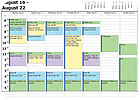Crafting Your Calendar
Ellen Rohr

I work with lots of contractors. Usually they are so busy that they have a hard time fitting in lunch or making it home before 7 p.m. When I ask to see a busy small-shop owner’s calendar, I often receive a blank look.
“Calendar?”
“Sure, where you jot down all the things you intend to do during the day,” I reply.
Most of the time, the “calendar” is a mess of Post-it® reminders or inked notes in the palm of his hand.
The busiest folks I know have empty calendars. I’m a fan of regularly scheduled meetings to keep in touch with the rest of the team. Even if the rest of the team is your wife, it helps to have a standing appointment to discuss the business. Otherwise business seeps into the cracks between 10:15 p.m. and 10:30 p.m - not a good time to discuss accounts receivables.
You also need time to work on projects, turn wrenches, attend your kid’s T-ball games, think about your place in this amazing universe - and fit in a round of golf. Without a calendar, you are going to neglect some aspect of your life.
Start committing your activities to a calendar and you will find …
A Few Tips For Planning Your Time
Hold sacred a once-a-week planning meeting with you. Look over your Master To-Do List. (I use a simple, one-subject, spiral-bound notebook for my to-do list. It’s an easy way to write down everything I need to do in one place.)
Consider the family activities. Look over your business plan and current financials. Then, update your calendar for the week before the week starts. I suggest holding this meeting Sunday night or early Monday morning.
Schedule formal meetings. Even in a small shop, schedule time to meet with the other members of the team. That way, when someone starts to interrupt what you are currently doing, you can say, “Let’s discuss that at our meeting.”
Don’t schedule more than two hours at a time for projects. You will waste time if you block out a whole day. Really, in an eight-hour day, how many hours of real production will you create? Two? So block out two-hour time periods and start and stop on time.
Your calendar won’t be much help unless you consult it. Do so, several times a day.
If you are in the office much of your time, consider using Microsoft Outlook. Are you a Mac user? Look into iCalendar. Use the recurring appointment feature and set up regular meetings once, and see them on your calendar every week.
The sample calendar in this article is from Outlook. You can sync your calendar to your Treo, Smart Phone or PDA when you hit the road. Nice!
If you are a low-tech person, use a “Week At A Glance” spiral-bound calendar. Take your calendar and your Master To-Do List with you wherever you go. It takes some practice to get into the habit. Commit!
As you develop good time-management habits, share this life-enhancing tactic with one of your team members. Mock up a typical week together and help him or her be more productive.

Take a look at the sample calendar week in Figure 1. I put this together imagining a small-shop owner with three plumbers (Jeff, Bill and Stacy) and one part-time office employee (Sue). I assumed the owner was handling some office and financial duties, as well as taking the occasional service call.
Your situation may differ. Take a swing at putting together a calendar for yourself. In my example, there are scheduled appointments to meet with your team (formal meetings with someone else are colored orange). There’s plenty of project time (purple) planned. And regular duties are scheduled in compact time periods (colored blue). The green-colored appointments are for personal and family commitments.
And there are still 15 hours left on Monday through Friday to fill in with general “fire-fighting” and service calls, if you are still working in the truck part-time.
You can always move appointments around as the week develops. However, if you move your project appointments around a few times, it may start to bother you. Commit to the time and work on that project. It feels so good to get things done. When the appointed time is over, set aside some more time on your calendar to work on that project; pick up where you left off when the next appointment time comes around. You can leave clues for yourself in the appointment notes so that you know where to start next time.
Of course, if an upset customer calls, the customer takes priority. Or if your wife calls with a family emergency, just go back to the calendar and rearrange as needed. If you fall off the wagon and neglect your calendar for a few days, don’t panic. Gently remind yourself that you are so much more productive (and relaxed!) when you operate with a tightly crafted calendar. Jump back on the wagon.
Links
Looking for a reprint of this article?
From high-res PDFs to custom plaques, order your copy today!





